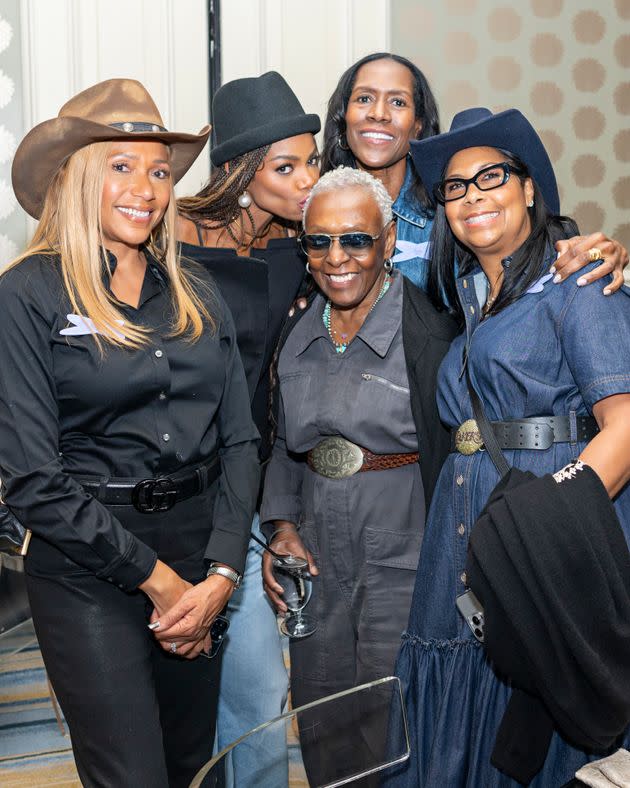The Godmother Of Fashion Is Not Done Fighting For Representation

Inher2023 documentary, “Invisible Beauty,” Bethann Hardison recognizes living history by being the embodiment of it. She knows the firsts and the lasts. She knows the models, the campaigns and the covers. She knows the designers and the movements that have made the fashion industry what it is today because she was part of so much of it.
But memory is fleeting as historic firsts get lost in time. Every new generation reimagines the past differently. In an interview with HuffPost, Hardison pointed out how some young people will ask her about the paucity of Black models, believing that they are few and far between, not realizing that there have always been Black people at fashion’s forefront.
“[They are] not looking or not aware and ask, ‘Do you think there’s ever going to be Black models doing this?’ and don’t realize that it already happened,” she said, when I spoke to her at 2024’s Leading Women Defined conference in Dana Point, California. “They get misconstrued and say the wrong thing that’s not accurate. There’s this misconception that at one point there used to be no Black designers, but there were. They’ll say that Ralph Lauren never had any Black models before Tyson Beckford came along, but there were.”
That confusion is rooted in a truth. Fashion can be unfair. Fashion is not for the faint of heart. “It’s a very difficult business,” Hardison told me. “It’s always been tough. Always been tight. It’s always had designers of color in it. It comes and goes in waves in who can really stand the test of time and be noticed.”
Hardison was more than noticed at Leading Women Defined, an exclusive and highly curated leadership event for women of color that was founded by former BET chief executive Debra L. Lee. This was Hardison’s fifth appearance at the summit, which was held for the 15th time Feb. 29 through March 4.
At the conference, participants watched “Invisible Beauty” during an after-hours “pajama party” at the Ritz-Carlton Laguna Niguel. While noshing on Garrett’s Chicago mix popcorn and sipping cocktails, we saw supermodels like Beckford, Naomi Campbell and Iman grace the documentary that chronicled Hardison’s life’s work to mentor young talent and champion diversity in fashion.
A former model herself, Hardison became an industry mainstay for her work with young talent, particularly models of all backgrounds, whom she represented and mentored as an agent. Over time, she found herself in opposition with white fashion houses that treated diversity as a trend at best and invisible at the least. At first, she wanted the documentary to be more of an exposé. Hardison wanted to hear the designers actually say what most already knew — they didn’t want to book Black talent because, in their minds, it didn’t fit their “brand.”
“Models [of color] had disappeared. Models that worked for six, seven years went dormant for five years,” she said. “At some point [while working on the documentary], I realized I wasn’t going to get white designers to say, ‘I don’t book Black girls.’”
The documentary’s focus then pivoted to her career and her work in diversity. Initially reluctant to have the spotlight on her, Hardison soon began to see what everyone else saw in her, with the film coming together as a living history and tribute to diversity in fashion and Hardison’s role in supporting that.
Today, Hardison believes that one of the biggest issues for designers of color is just how difficult it is to stay afloat. “They don’t have the finances to do it,” she said. And that is evidenced in how many heralded but fledging Black designers whose names were bandied about only a few years ago are now struggling to produce lines and selling clothes atsteepdiscounts, or haven’t updated their websites in months or longer.
“The only place where you can improve anything is when people get sponsorship — to provide finances for designers to have businesses,” Hardison added. “It’s not necessarily a Black thing, but that’s who feels it more because they don’t have the income.”
Leading Women Defined, by showcasing Hardison, as well as hosting an on-site marketplace featuring Black designers, sought to help those often overlooked by not only getting them the recognition they deserve, but the dollars. Participants in the conference visited the boutique daily, dropping thousands on vendors like Fe Noel and Soul Gems by Maria.
According to Hardison, navigating the business side is the true final frontier for Black Americans in fashion. “I don’t know if there’s another mountain to climb other than can we get business people to teach brands of color how to do business and do it well,” she said.


